| |||||
| Decades: | |||||
|---|---|---|---|---|---|
| See also: | Other events of 1407 History of France • Timeline • Years | ||||
Events from the year 1407 in France
| |||||
| Decades: | |||||
|---|---|---|---|---|---|
| See also: | Other events of 1407 History of France • Timeline • Years | ||||
Events from the year 1407 in France
The Capetian dynasty, also known as the House of France, is a dynasty of Frankish origin, and a branch of the Robertians. It is among the largest and oldest royal houses in Europe and the world, and consists of Hugh Capet, the founder of the dynasty, and his male-line descendants, who ruled in France without interruption from 987 to 1792, and again from 1814 to 1848. The senior line ruled in France as the House of Capet from the election of Hugh Capet in 987 until the death of Charles IV in 1328. That line was succeeded by cadet branches, the Houses of Valois and then Bourbon, which ruled without interruption until the French Revolution abolished the monarchy in 1792. The Bourbons were restored in 1814 in the aftermath of Napoleon's defeat, but had to vacate the throne again in 1830 in favor of the last Capetian monarch of France, Louis Philippe I, who belonged to the House of Orléans. Cadet branches of the Capetian House of Bourbon house are still reigning over Spain and Luxembourg.
Year 1407 (MCDVII) was a common year starting on Saturday of the Julian calendar.
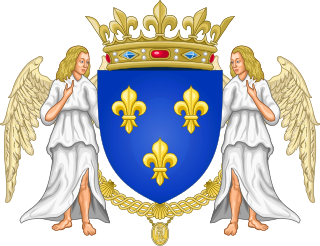
The Capetian house of Valois was a cadet branch of the Capetian dynasty. They succeeded the House of Capet to the French throne, and were the royal house of France from 1328 to 1589. Junior members of the family founded cadet branches in Orléans, Anjou, Burgundy, and Alençon.

Philip II the Bold was Duke of Burgundy and jure uxoris Count of Flanders, Artois and Burgundy. He was the fourth and youngest son of King John II of France and Bonne of Luxembourg.

Louis XI, called "Louis the Prudent", was King of France from 1461 to 1483. He succeeded his father, Charles VII.

Charles VI, nicknamed the Beloved and later the Mad, was King of France from 1380 until his death in 1422. He is known for his mental illness and psychotic episodes that plagued him throughout his life.

Charles of Orléans was Duke of Orléans from 1407, following the murder of his father, Louis I, Duke of Orléans. He was also Duke of Valois, Count of Beaumont-sur-Oise and of Blois, Lord of Coucy, and the inheritor of Asti in Italy via his mother Valentina Visconti.
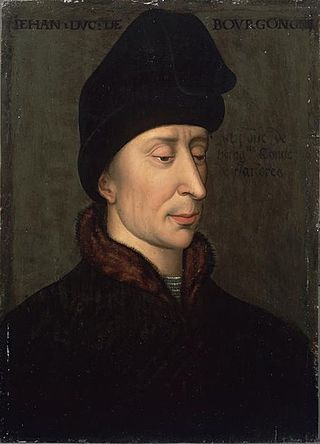
John I was a scion of the French royal family who ruled the Burgundian State from 1404 until his death in 1419. He played a key role in French national affairs during the early 15th century, particularly in the struggles to rule the country for the mentally ill King Charles VI, his cousin, and the Hundred Years' War with England. A rash, ruthless and unscrupulous politician, John murdered the King's brother, the Duke of Orléans, in an attempt to gain control of the government, which led to the eruption of the Armagnac–Burgundian Civil War in France and in turn culminated in his own assassination in 1419.

Louis I of Orléans was Duke of Orléans from 1392 to his death. He was also Duke of Touraine (1386–1392), Count of Valois (1386?–1406) Blois (1397–1407), Angoulême (1404–1407), Périgord (1400–1407) and Soissons (1404–07).
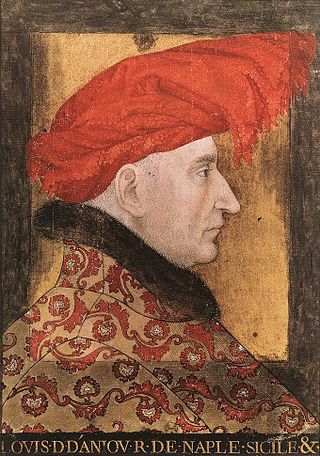
Louis II was Duke of Anjou and Count of Provence from 1384 to 1417; he claimed the Kingdom of Naples, but only ruled parts of the kingdom from 1390 to 1399. His father, Louis I of Anjou—the founder of the House of Valois-Anjou—was a younger son of King John II of France and the adopted son of Queen Joanna I of Naples. When his father died during a military campaign in Naples in 1384, Louis II was still a child. He inherited Anjou from his father, but his mother, Marie of Blois, could not convince his uncles, John, Duke of Berry and Philip II, Duke of Burgundy, to continue her husband's war for Naples. The Provençal nobles and towns refused to acknowledge Louis II as their lawful ruler, but Marie of Blois persuaded them one after another to swear fealty to him between 1385 and 1387.

Isabeau of Bavaria was Queen of France from 1385 to 1422. She was born into the House of Wittelsbach as the only daughter of Duke Stephen III of Bavaria-Ingolstadt and Taddea Visconti of Milan. At age 15 or 16, Isabeau was sent to France to marry the young King Charles VI; the couple wed three days after their first meeting.
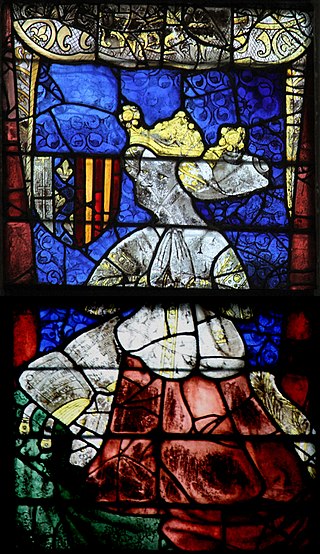
Yolande of Aragon was Duchess of Anjou and Countess of Provence by marriage, who acted as regent of Provence during the minority of her son. She was a daughter of John I of Aragon and his wife Violant of Bar. Yolande played a crucial role in the struggles between France and England, influencing events such as the financing of Joan of Arc's army in 1429 that helped tip the balance in favour of the French. She was also known as Yolanda de Aragón and Violant d'Aragó. Tradition holds that she commissioned the famous Rohan Hours.

Valentina Visconti was a countess of Vertus, and duchess consort of Orléans as the wife of Louis I, Duke of Orléans, the younger brother of King Charles VI of France. As duchess of Orléans she was at court and acquired the enmity of the Queen of France, Isabeau of Bavaria-Ingolstadt, and was subsequently banned from the court and had to leave Paris. Due to political animosity, Valentina's husband was murdered in 1407. She died on 4 December 1408.
The Armagnac faction was prominent in French politics and warfare during the Hundred Years' War. It was allied with the supporters of Charles, Duke of Orléans against John the Fearless after Charles' father Louis of Orléans was killed on a Paris street on the orders of the Duke of Burgundy on 23 November 1407.

The Burgundian party was a political allegiance against France that formed during the latter half of the Hundred Years' War. The term "Burgundians" refers to the supporters of the Duke of Burgundy, John the Fearless, that formed after the assassination of Louis I, Duke of Orléans. Their opposition to the Armagnac party, the supporters of Charles, Duke of Orléans, led to a civil war in the early 15th century, itself part of the larger Hundred Years' War.

Louis was the eighth of twelve children of King Charles VI of France and Isabeau of Bavaria. He was their third son and the second to hold the titles Dauphin of Viennois and Duke of Guyenne, inheriting them in 1401, at the death of his older brother, Charles (1392–1401).

The House of Valois-Burgundy, or the Younger House of Burgundy, was a noble French family deriving from the royal House of Valois. It is distinct from the Capetian House of Burgundy, descendants of King Robert II of France, though both houses stem from the Capetian dynasty. They ruled the Duchy of Burgundy from 1363 to 1482 and later came to rule vast lands including Artois, Flanders, Luxembourg, Hainault, the county palatine of Burgundy (Franche-Comté), and other lands through marriage, forming what is now known as the Burgundian State.
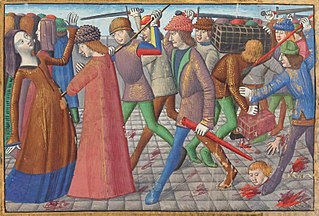
The Armagnac–Burgundian Civil War was a conflict between two cadet branches of the French royal family – the House of Orléans and the House of Burgundy from 1407 to 1435. It began during a lull in the Hundred Years' War against the English and overlapped with the Western Schism of the papacy.
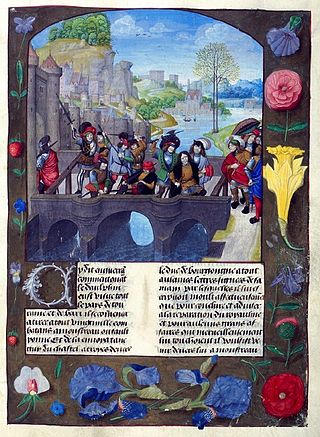
John the Fearless, Duke of Burgundy, was assassinated on the bridge at Montereau on 10 September 1419 during a parley with the French dauphin, by Tanneguy du Chastel and Jean Louvet, the dauphin's close counsellors.
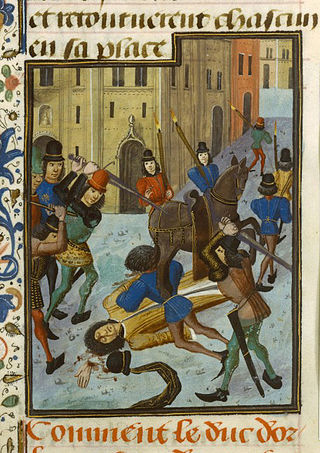
The assassination of Louis I, Duke of Orléans took place on November 23, 1407 in Paris, France. The assassination occurred during the power struggles between two factions attempting to control the regency of France during the reign of Charles VI, who was seen as unfit to rule due to his mental illness. One faction was led by Louis, the king's younger brother, and Queen Isabeau of Bavaria, Charles' wife. They attempted to seize control of the country from the House of Burgundy after the death of the powerful Duke of Burgundy, Philip the Bold, in 1404.